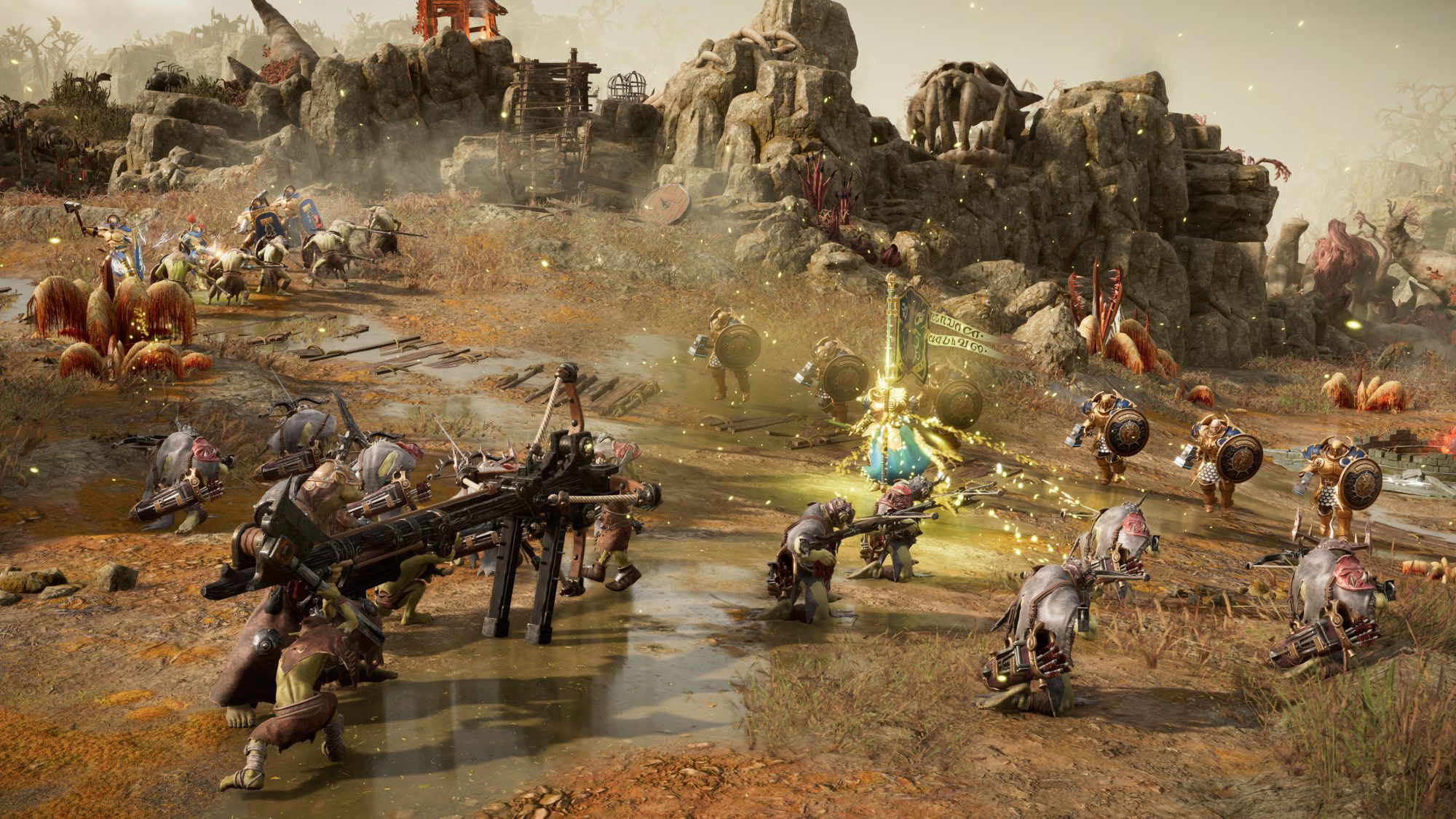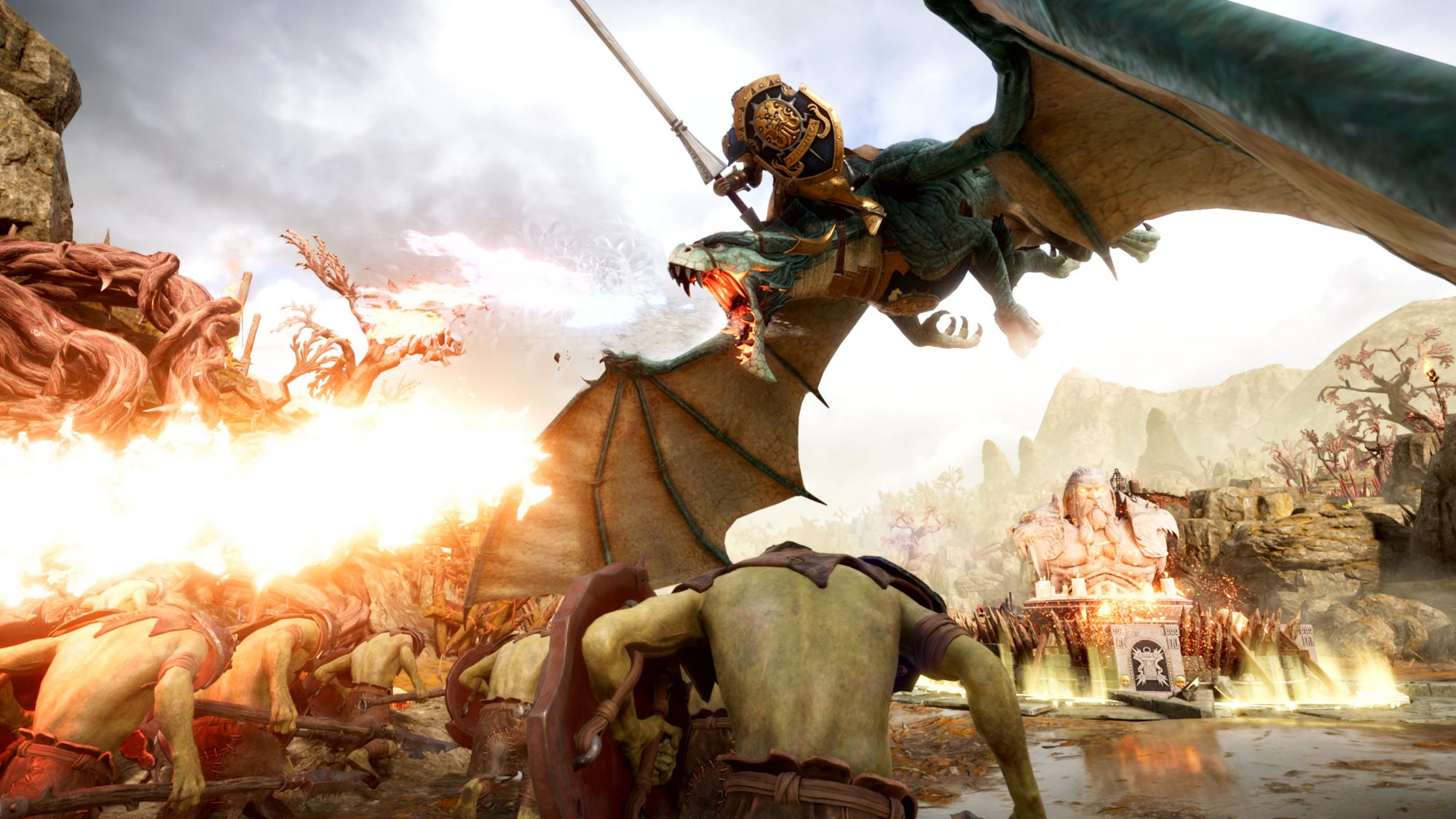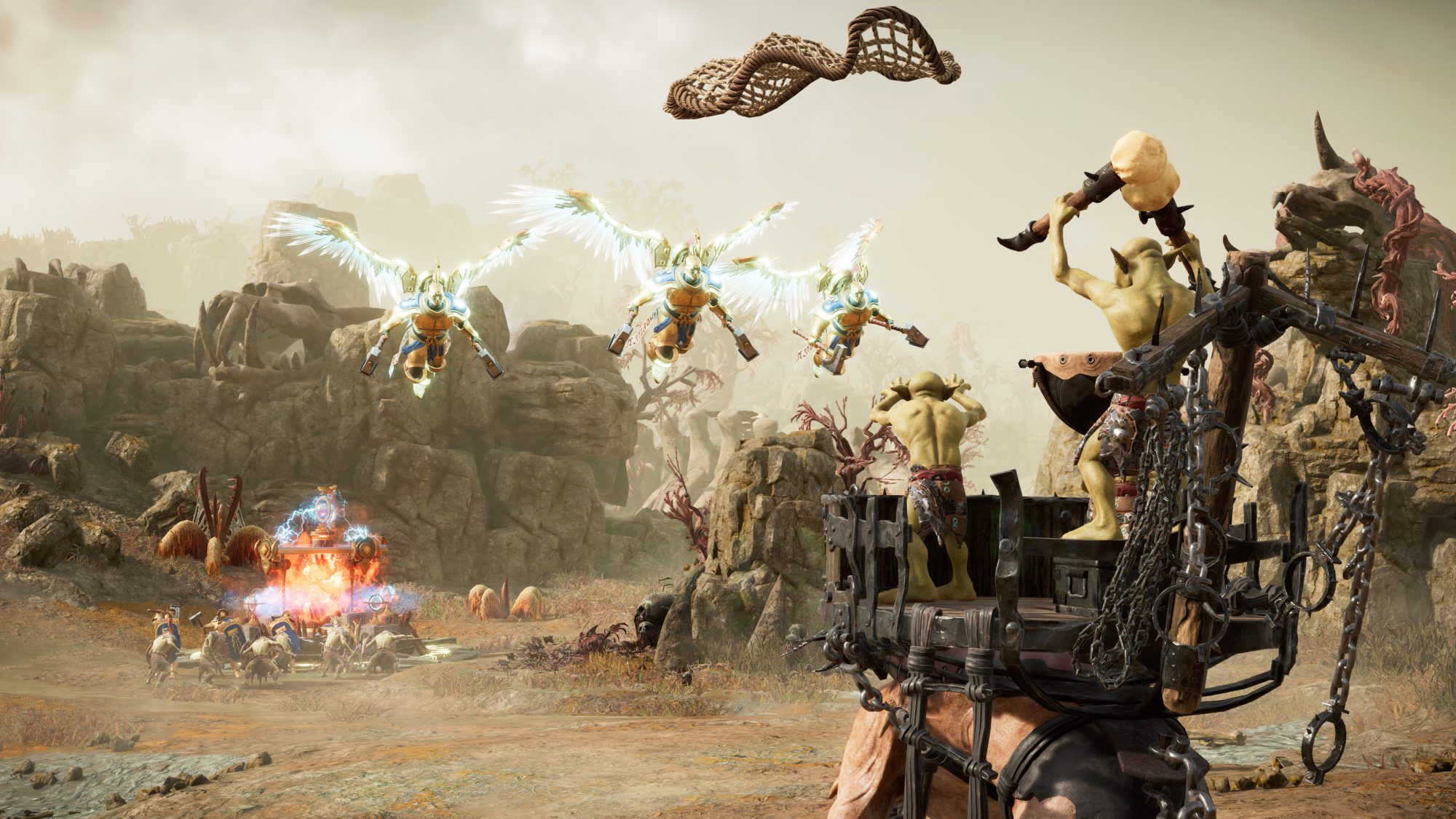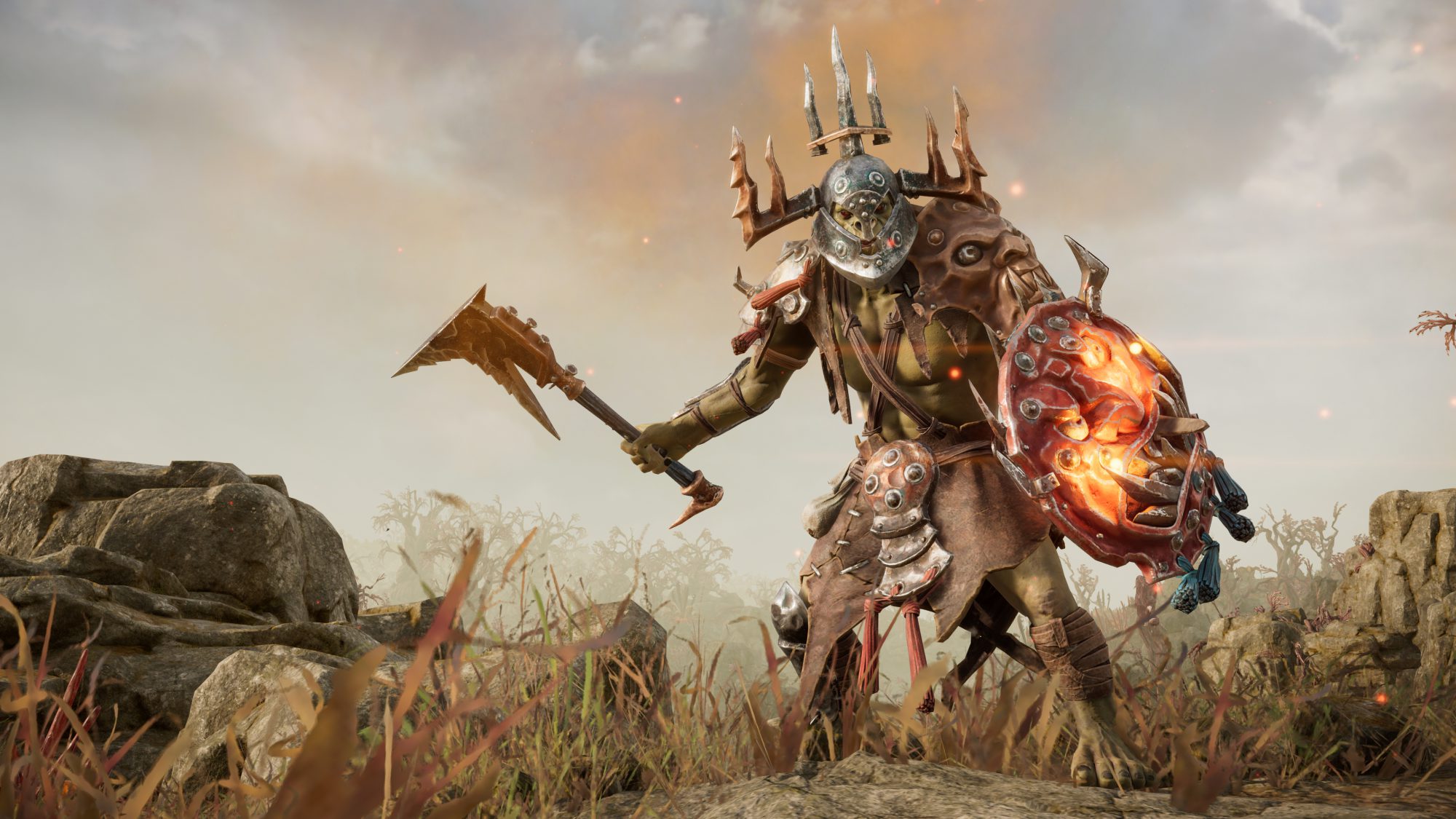The fine folks over at Frontier Developments invited us to play the upcoming Age of Sigmar: Realms of Ruin in a remote hands-on event. This was handled via the remote-play app Parsec, and involved both single and multiplayer gameplay.
Whose Age is it, Anyway?
Age of Sigmar: Realms of Ruin is the first real time strategy game based in the Warhammer: Age of Sigmar setting. While there have been other attempts to bring the Mortal Realms into the digital one, none have made a huge splash on par with the Warhammer Total War or Warhammer 40,000 Dawn of War games. As a lifelong RTS player (and half my life-long Warhammer player) I was particularly stoked to give this game a try, and was invited to a preview event where I got to play an early build alongside some other members of the gaming press.
Core Gameplay
Your average match of Realms of Ruin will have you fight over a map where you can control resource points, either rewarding you with blue or orange resources – Command and Realmstone. Think Minerals and Vespene, Requisition and Power, and so on. These resources can be spent on units, abilities, and upgrades. In addition to these resource points, you capture critical locations which cause your opponent’s score to tick down. If you’ve played Company of Heroes, Dawn of War II, or even the Battlefield series, you should have a pretty good idea of how this works. Destroying your opponent’s HQ building will also do the trick, though this never came about in the games I played. There is only an extremely light base building element here, which I know may disappoint some people. Once you capture resource points, you can spend resources to build 4 different kinds of outposts on them, either providing extra line of sight, resources, healing, or defensive weapons. I feel like the line of sight option has a lot of competition in that slot, as being able to generate more resources or heal your squads for free are both extremely tough to trade for. These all raise your population cap, so you’re incentivized to grab these points and get building. Personally, I’m here to be a general, not an urban planner, so I’m very cool with this limited approach to base building.
This won’t be the last time I bring this up, but this game feels a lot like Dawn of War II. This is extremely good news for me, as that’s my favorite of the series. You’ll generally be running with anywhere from half a dozen to 20 units, consisting of heroes, troops, monsters and war machines. There’s a sort of rock, paper, scissors dynamic between said units (something akin to heavy troops beating light troops, ranged troops beating heavy troops, and light troops beating ranged troops) that is upset by the monster and hero units in the game. This encourages you to build a variety of units instead of just spamming one thing like in my Starcraft II bronze league days.
Every unit in the game has at least 1 ability, and usually 2, triggered by the Q and E keys or the bumpers on your controller. This is where a lot of the flavor comes in, with spells and abilities taken straight from the tabletop. This is how you might trigger a charge move, a Stormdrake Guard’s fire breath, or Kruleboy Skare Shields. This micromanagement is where battles will often be won or lost, and are where the factional diversity is most apparent. Each of these cost resources instead of just being on a timer or energy bar, so spamming them could get costly. I have some minor qualms with these, as much as I generally like them. My first is that the button for charging switches over to a button for retreating once the unit gets into combat. This lead to me accidentally retreating with a full strength unit I meant to charge with, losing me a border skirmish. Retreat also couldn’t be used unless a unit was in melee combat, so if your guys were getting shot up you were out of luck. I hope retreating can be remapped or otherwise changed in the future, because having your master plan fall apart when an errant Hobgrot wanders slightly too close to your battleline doesn’t feel great. My second issue is that you can’t find out what these abilities do until you’ve clicked them once, where you’ll get a little tooltip saying what they do, and you can confirm from there. Even then, you can’t figure that out until you’ve got enough resources to potentially spend on the ability. I wish there was just a button I could hold down that would have a textbox appear around every ability, or there was a mouseover popup for each, but once you’ve played with a unit enough times you’ll get the picture.
There’s a satisfying stickiness to the combat in this game, where units live long enough to actually duke it out and let their controlling players react. Oftentimes in a game of Starcraft or Company of Heroes, combat is balanced on a knife’s edge and if you didn’t space things properly or you looked away for a second, suddenly your whole army would be wiped out. While there are powerful units and abilities that can make short work of your units if used correctly, by and large squads will stick around in some capacity for a minute once they’ve engaged the enemy. More often than not, a scuffle between a few units will involve trading blows and abilities until one group retreats or a flanking unit from one side surrounds the other and cuts them off. This also means that units will hang out long enough for you to use their abilities, understand what’s going on, and react instead of a sudden grenade or Baneling bust ruining your plans in the blink of an eye.
Single Player
Our hands on demo began with a single player mission to learn the ropes. We started by exploring the map with a single unit of Vanguard Hunters, a mixed melee/shooting recon unit available to the Stormcast faction. It taught players the basic controls, how abilities work, plus other basics like capturing objectives and replenishing casualties. After a certain point, your troops get ambushed, and the perspective shifts over to a pair of the campaign’s heroes and their retinue. This was done through an in-engine cutscene with some solid performance capture, direction, and voice acting. Our options opened up here, as we had multiple heroes to work with, a greater variety of units, and some bigger battles with more varied objectives than the first half of the mission. Sometimes you would be killing wild Ghurish creatures, other times you’d be tearing down Kruleboyz camps in an attempt to find the lost patrol. The two main characters had some enjoyable banter, and the slower pace of single player meant I really got to zoom in and appreciate the models and animations here. I hope people take the time to stop and admire the details, because the team at Frontier didn’t spare a single one. They did a fantastic job getting the look and feel down for each unit, with characterful idle animations and big, legible attacks and abilities. My favorite was the Knight-Vexillor, who would plant his flag before running into combat, only to summon it back to him in a lightning bolt after a fight.
The single player story is written by veteran Black Library and Games Workshop writer Gav Thorpe, and the team worked closely with him to make it feel as authentic as possible. I can’t say I got a great feel for the story based on the banter and cutscenes of a single mission. What I saw was well produced and acted though, and I’m interested to see where it goes. The single player campaign will switch from faction to faction in some capacity, and the story will unfold from multiple perspectives. Even having played AoS since the first General’s Handbook, I’ve only been immersed in so many stories in the setting, so I’m excited to see it come to life here.
Multiplayer
In our demo, only 2 of the game’s 4 races were available to play: The Stormcast Eternals and the Kruleboyz. We were each matched up with another player of similar experience and had 3 games to try stuff out. I got absolutely bodied in my first Stormcast vs. Stormcast game, put up a damn good fight in a Kruleboyz vs. Kruleboyz game before getting defeated, and then got bodied a third time as Kruleboyz vs Stormcast. All 3 were against the same opponent, who was absolutely delightful to talk to after the fact, but she was far and away better at RTS games than I am.
The rhythm of each match will feel familiar to anyone who has put a good amount of time into Dawn of War II or any of the Company of Heroes games, with shifting battlelines, far-ranging scouts causing a ruckus in the backfield, and skirmish after skirmish being decided by who retreats where and when. Like those other games, each army feels distinct. Predictably, the Stormcast are a tankier and more beginner-friendly faction, while the Kruleboyz fall somewhere between horde and finesse army, with some powerful late-game monsters. You have a tech tree with various upgrades, many of which I was delighted to see appear on the models. I only discovered the tree in my 3rd and final game, but was happy to see my Killaboss was now riding a Gnashtoof instead of just hoofing it everywhere.
Multiplayer feels like where Realms of Ruin will truly come to life, and where it most mirrors the tabletop. It’s by no means a 1:1 adaptation of the game I’ve been playing for the past 6 years, but is where that certain Age of Sigmar je ne sais quoi truly kicks in. Positioning, army composition, and timely use of special abilities matter more in the less forgiving environment of multiplayer. After my games, I went back through the Age of Sigmar app and saw almost every ability I triggered was taken straight from each unit’s Warscroll, just adapted for this different medium. In cases like the Breaka-boss on Mirebrute Troggoth, his Breaka-harness and Regeneration abilities caused damage to himself to hit harder and then regained health back over time, just like on the Warscroll. Liberators, on the other hand, don’t have much in the way of special rules in AoS. Here they gained a shield wall ability that not only gives them a distinct role as the tankiest of tanky infantry, but reinforces their narrative as an indomitable wall of Sigmarite. It was particularly fun playing the Kruleboyz and looking up all their units and how they were adapted for the game, as they’re not a faction I’m particularly familiar with. They aren’t even an army I liked that much before, but after playing a few games with them I felt like I not only understood how they functioned in Realms of Ruin, but how they fit into Age of Sigmar as a setting. Frontier absolutely nailed the feel of these factions, and I can only assume the other two yet to be revealed armies will be just as characterful.
They weren’t ready to tell me about army customization just yet, so all I can do is hope there is some means of painting your digital dudes. Cosmetic DLC is a layup for Warhammer games, and I’d love it if I could paint my Stormcast army to match my tabletop one. There was some visual confusion in my multiplayer games since there was only one color scheme available per faction, but I’d be shocked if, at the very least, there wasn’t something to distinguish each player’s force.
Controller Support
I have chronic wrist pain that is often exacerbated by mouse and keyboard use, so I was excited to see this game had controller support. As it’s also launching on consoles with cross-platform play, they seem to have put a lot more thought into how a controller would work for an RTS than most other games would. In a system that’s fairly intuitive (their trademarked DirectStep system), you flick your control stick to switch from unit to unit in that direction. For instance, if I have a squad on the left side of the map and another on the right, if I flick the stick right while holding the correct button, the camera will fly out all the way to the other side of the map and select that unit, stopping only if there is another unit between here and there. It works rather well, and shores up the slower reaction time inherent in using a controller versus a mouse. Once you have a unit selected, you can chain together coordinates on where you want them to go, toggle on and off attack moves with the triggers, and use abilities with the bumpers on your controller. It felt pretty natural after the single player mission, but I seemed somewhat disadvantaged in my multiplayer game. I won’t say it felt like quite the mismatch of playing a competitive shooter on a controller vs a keyboard, but it’s a gap in precision and speed that I don’t think we’re ever going to cross completely. That being said, it does feel pretty dang good, and I’m grateful that it’s in there. I think anything that can expose more console players to this genre is a good thing, and this is an approachable entry into the RTS field.
Audiovisual
As I have alluded to frequently here, this game is a delight to look at. The cutscenes look great, the units are dead ringers for their tabletop equivalents, and the animations are chunky and readable at a distance. Particle effects pop off from special abilities, but not so much that it becomes visually confusing. Unit barks and audio cues are every bit what I was hoping for, with some characterful distinctions between one type of unit and another. For example, Liberators sound classically stern and stoic, while Vanguard-Hunters have a Northern English accent and sound more rough around the edges. I could swear the Kruleboyz are using the same 3 voice actors that have been Orcs/Orks/Orruks in every Warhammer piece of media since 2004, and they’re having the time of their life with these lines. Lastly, the music was damn good. The bar for Warhammer soundtracks has definitely been raised with Mechanicus and Darktide, so we’ll see how this stacks up there, but I was surprised by how good it was. It all feels wonderfully cohesive, with an unobtrusive UI that really lets you take in the action.
Final Thoughts
It’s clear to me that the team at Frontier really, genuinely cares about the game they’re putting out and the world it’s set in. This isn’t just a generic RTS with an Age of Sigmar skin, but something that feels like Age of Sigmar. If you couldn’t tell, I had a great time playing this game, and its been looming in my mind for the week since. I’m looking forward to getting my hands on it again during the Open Beta on July 7-10, and I’ll be reporting my findings as this peek into the Age of Sigmar continues to shape up.
Have any questions or feedback? Drop us a note in the comments below or email us at contact@goonhammer.com.










